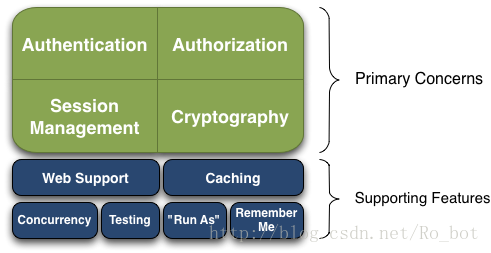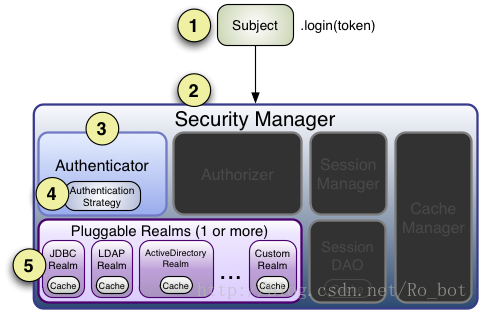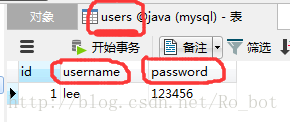Java 安全框架
作者:网络转载 发布时间:[ 2017/3/8 10:49:55 ] 推荐标签:测试开发技术 Java
简介
Apache Shiro是一个强大且易用的Java安全框架,执行身份验证、授权、密码学和会话管理。使用Shiro的易于理解的API,您可以快速、轻松地获得任何应用程序,从小的移动应用程序到大的网络和企业应用程序。
主要特性

Authentication(验证) Authorization(授权) Session Management(会话管理) Cryptography(加密) 身份认证(验证)

从配置文件获取用户密码 依赖
<dependency>
<groupId>org.apache.shiro</groupId>
<artifactId>shiro-core</artifactId>
<version>1.3.2</version>
<exclusions>
<exclusion>
<groupId>org.slf4j</groupId>
<artifactId>slf4j-api</artifactId>
</exclusion>
</exclusions>
</dependency>
<dependency>
<groupId>org.slf4j</groupId>
<artifactId>slf4j-log4j12</artifactId>
<version>1.7.23</version>
</dependency>
配置文件
shiro.ini
# 此处只是演示,实际项目中用户/密码会在数据库取得
[users]
lee=123456
log4j.properties
#
# Licensed to the Apache Software Foundation (ASF) under one
# or more contributor license agreements. See the NOTICE file
# distributed with this work for additional information
# regarding copyright ownership. The ASF licenses this file
# to you under the Apache License, Version 2.0 (the
# "License"); you may not use this file except in compliance
# with the License. You may obtain a copy of the License at
#
# http://www.apache.org/licenses/LICENSE-2.0
#
# Unless required by applicable law or agreed to in writing,
# software distributed under the License is distributed on an
# "AS IS" BASIS, WITHOUT WARRANTIES OR CONDITIONS OF ANY
# KIND, either express or implied. See the License for the
# specific language governing permissions and limitations
# under the License.
#
log4j.rootLogger=INFO, stdout
log4j.appender.stdout=org.apache.log4j.ConsoleAppender
log4j.appender.stdout.layout=org.apache.log4j.PatternLayout
log4j.appender.stdout.layout.ConversionPattern=%d %p [%c] - %m %n
# General Apache libraries
log4j.logger.org.apache=WARN
# Spring
log4j.logger.org.springframework=WARN
# Default Shiro logging
log4j.logger.org.apache.shiro=TRACE
# Disable verbose logging
log4j.logger.org.apache.shiro.util.ThreadContext=WARN
log4j.logger.org.apache.shiro.cache.ehcache.EhCache=WARN
HelloShiro.java
import org.apache.shiro.SecurityUtils;
import org.apache.shiro.authc.AuthenticationException;
import org.apache.shiro.authc.UsernamePasswordToken;
import org.apache.shiro.config.IniSecurityManagerFactory;
import org.apache.shiro.mgt.SecurityManager;
import org.apache.shiro.subject.Subject;
import org.apache.shiro.util.Factory;
public class HelloShiro {
public static void main(String[] args) {
// 读取配置文件,初始化 SecurityManager 工厂
Factory<SecurityManager> factory = new IniSecurityManagerFactory("classpath:shiro.ini");
// 获取 SecurityManager 实例
SecurityManager securityManager = factory.getInstance();
// 把 SecurityManager 实例绑定到 SecurityUtils
SecurityUtils.setSecurityManager(securityManager);
// 得到当前执行的用户
Subject currentUser = SecurityUtils.getSubject();
// 创建 token 令牌,用户名/密码
UsernamePasswordToken token = new UsernamePasswordToken("lee",
"123456");
try {
// 登录
currentUser.login(token);
System.out.println("身份认证成功");
} catch (AuthenticationException e) {
e.printStackTrace();
System.out.println("身份认证失败");
}
// 退出
currentUser.logout();
}
}
执行成功

执行失败,即用户名或密码错误

以上是一简单的 Shiro 实例。
从数据库获取用户密码
此过程根据上述代码修改
依赖
<dependency>
<groupId>com.mchange</groupId>
<artifactId>c3p0</artifactId>
<version>0.9.5.2</version>
</dependency>
<dependency>
<groupId>mysql</groupId>
<artifactId>mysql-connector-java</artifactId>
<version>5.1.39</version>
</dependency>
<!-- org.apache.shiro.util.AbstractFactory.getInstance需要 -->
<dependency>
<groupId>commons-logging</groupId>
<artifactId>commons-logging</artifactId>
<version>1.2</version>
</dependency>
配置文件
jdbcRealm.ini
[main]
# 使用数据库保存的用户密码
jdbcRealm=org.apache.shiro.realm.jdbc.JdbcRealm
# 数据源
dataSource=com.mchange.v2.c3p0.ComboPooledDataSource
dataSource.driverClass=com.mysql.jdbc.Driver
dataSource.jdbcUrl=jdbc:mysql://localhost:3306/java
dataSource.user=root
dataSource.password=root
# 设置 jdbcRealm 数据源
jdbcRealm.dataSource=$dataSource
# 设置 securityManager 的 realm,多个逗号隔开
securityManager.realms=$jdbcRealm
SQL 文件
在编写 SQL 时先说明下,Shiro 默认是根据提供的数据库,去寻找users的表,用户名和密码字段为username和password。格式如下:

JdbcShiro.java
// 此处只需改变配置文件即可,其它代码与上述 HelloShrio 代码一致
Factory<SecurityManager> factory = new IniSecurityManagerFactory("classpath:jdbcRealm.ini");
权限认证(授权)
核心的三个要素:权限,角色和用户。
ShiroUtils.java
import org.apache.shiro.SecurityUtils;
import org.apache.shiro.authc.AuthenticationException;
import org.apache.shiro.authc.UsernamePasswordToken;
import org.apache.shiro.config.IniSecurityManagerFactory;
import org.apache.shiro.mgt.SecurityManager;
import org.apache.shiro.subject.Subject;
import org.apache.shiro.util.Factory;
public class ShiroUtils {
public static Subject login(String iniResourcePath, String username, String password) {
// 读取配置文件,初始化 SecurityManager 工厂
Factory<SecurityManager> factory = new IniSecurityManagerFactory(iniResourcePath);
// 获取 SecurityManager 实例
SecurityManager securityManager = factory.getInstance();
// 把 SecurityManager 实例绑定到 SecurityUtils
SecurityUtils.setSecurityManager(securityManager);
// 得到当前执行的用户
Subject currentUser = SecurityUtils.getSubject();
// 创建 token 令牌,用户名/密码
UsernamePasswordToken token = new UsernamePasswordToken(username, password);
try {
// 登录
currentUser.login(token);
System.out.println("身份认证成功");
} catch (AuthenticationException e) {
e.printStackTrace();
System.out.println("身份认证失败");
}
return currentUser;
}
}
相关推荐

更新发布
功能测试和接口测试的区别
2023/3/23 14:23:39如何写好测试用例文档
2023/3/22 16:17:39常用的选择回归测试的方式有哪些?
2022/6/14 16:14:27测试流程中需要重点把关几个过程?
2021/10/18 15:37:44性能测试的七种方法
2021/9/17 15:19:29全链路压测优化思路
2021/9/14 15:42:25性能测试流程浅谈
2021/5/28 17:25:47常见的APP性能测试指标
2021/5/8 17:01:11













 sales@spasvo.com
sales@spasvo.com